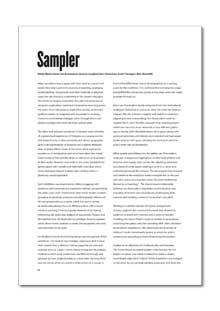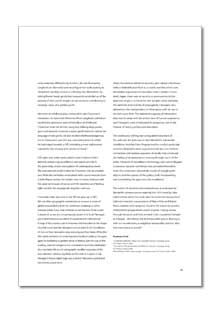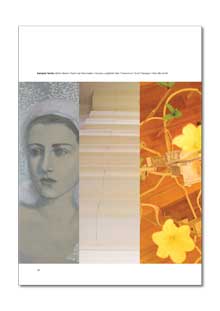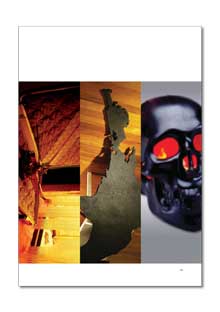 |
|||||||||
|
|
| ...Publications: Annual | ...Sampler. | |||||||||||||
|
Sampler. Robin Neate, Karin van Roosmalen, Joanna Langford, Iain Cheesman, Scott Flanagan, Alex Monteith When an artist enters a space with their work to unpack and install, they begin and end a journey of adapting, arranging and inhabiting - temporarily with their materials in physical space but also hanging indefinitely in the viewer’s thoughts. The artists in Sampler excelled in this, with the processes of escapism, exploration, travel and colonisation recurring across the series of six solo projects. Each drew heavily on histories (political, artistic or imagined) and succeeded in evoking memories and internal dialogue, some through kitsch and playful nostalgia and some via more cynical satire. The ideas and attitudes pondered in Sampler seem reflective of a generalised experience of Aotearoa as a young country that keeps history in close proximity and whose geography gives it an appreciation of distance and a slightly removed view of global affairs. Some of the artists share a personal experience of immigration and most have taken the virtual travel worlds of film and literature as references or inspiration in their works. However each artist in the series inhabited the gallery space with visually and materially individual works. Some displayed elegant restraint and subtlety, others a gloriously playful approach. Each exhibition was impressively crafted, engaging with audiences and contemporary experience without compromising the artists’ own style. Christchurch artist Robin Neate’s untitled grouping of paintings, sculpture and photography referenced his own progression as an artist which has seen a variety of media take primary focus at different points, with a recent return to painting. It traced popular elements of art history, referencing the styles and subjects of Giacometti, Pissarro and Michael Harrison. Yet Neate did not privilege these recognised artists above hobby painters or street photographers, who also had a presence in his work. An idealised Paris formed the backdrop and atmosphere of this exhibition - the kind of rosy nostalgic impression that is most vivid viewed from a distance. Taking magazine pictures and reproductions as subject matter, Neate re-enacted the primary method in which early modernism was filtered through and adopted by New Zealand artists, at a time when far away Paris was the centre of the art world. A 1950s photo of a couple in front of the Eiffel Tower was re-photographed as a starting point for the exhibition. This well-travelled and adapted image exemplified the connection points across place and time made possible through art. Karin van Roosmalen’s family emigrated from the Netherlands settling in Christchurch, and as an adult the artist has lived an itinerant life. Her artwork is equally well suited to travel and adapting to new surroundings. Van Roosmalen’s work for Sampler Much Like a Traveller, was part of an ongoing project which saw the artist reuse materials in four different gallery spaces during 2004. Moulded sheets of art paper along with personal ephemera and objects were selected and rearranged by the artist in each space, allowing the work (and artist) to subtly settle into its destination. While quietly assimilating into the gallery, van Roosmalen’s work also changed and highlighted architectural oddities and histories, with a peep-hole cut into the adjoining storeroom and sheets of white paper creating a curve in a corner and softening previously flat surfaces. The many layers thus revealed and hidden in the exhibition made a tangible link to the past and other places, in a way that writer Charlotte Huddleston likened to archaeology.1 The impermanent relationship between van Roosmalen’s installation and its location was evocative of viewers’ own associations of belonging, time, memory and building a sense of home when cast adrift. Working in a similar manner of organic arrangement, Joanna Langford also constructed a work that allowed its audience to travel with memory and a sense of wonder. Installing The Flower People Langford worked as an explorer, colonising the gallery with her sprawling MDF cities inhabited by miniature populations. The adventures and journeys of children’s books immediately sprang to mind, the artist’s construction appearing as three-dimensional illustration. Fuelled by recollections of childhood play and fairytales, The Flower People recreated a belief in the fanciful. Yet the playful escapism and kitsch construction belies a darker, more fragile edge. Each “colony” of the installation was bridged to the other by precariously winding roads and, built from the same materials, differed only in form. Like van Roosmalen, Langford can dismantle and reconfigure her work, making its inhabitants’ worldly existence a fleeting one. Meanwhile the ticking flower heads gently but incessantly reminded us of the passing of time and its impact on our memory contributing to nostalgic views of a golden youth. Elements of childhood play continued in Iain Cheesman’s installation An Automatic Welcome. While Langford’s exhibition recalled the adventure and territorialism of childhood, Cheesman took this further using toys (talking dogs, plastic guns) and domestic materials (carpet, garish fabrics) to satirise the language of war games. He also recalled childhood imaginings, but in Cheesman’s case this was a recurring dream in which his bed edged towards a cliff, intimating a more nightmarish concern for the security and comfort of home. 2 LED lights and video works added a low-fi science fiction element, referencing surveillance and airport security in the potentially sinister atmosphere of contemporary travel. The international world evoked by Cheesman was an unstable one. While the exhibition entertained (with sound excerpts from a John Wayne movie), the sinister mise-en-scene seduced with the same techniques of pomp and frill, repetition and flashing lights used in the propaganda of politics and war. Cheesman (who was born in the UK but grew up in NZ), did not allow geographic remoteness to remove a sense of global responsibility from his exhibition, implying as other Sampler artists have, that whether or not the rest of the world is aware of us,we are conspicuously aware of it. Scott Flanagan presented Aotearoa as a kind of experiment in nationhood. A map of the country cast in bitumen and moulded to the shape of a bell-curve was the eloquent central point in his installation Dr Don: or how I learned to stop worrying and love Helen.While the title made reference to contemporary localised politics, Flanagan gave his exhibition a greater sense of history with his use of the roading material integral in the colonisation and industrialisation of a new land.His act of cartography recalled explorers of the seas; whether referencing Maui and his fish or Captain Cook, Flanagan’s heavy black map was a land of discovery pulled and forced into a taut form. Shaky foundations hinted at ancestry and cultural inheritance (with a skeletal human foot as a crutch) and the artist’s own dissatisfied experience of education (with a broken school desk). Again, there was no security or permanence to the depiction of place or home for this Sampler artist. Satirising the methods and controls of propaganda, Flanagan’s also delved into the manipulation of information with his use of the bell-curve form. The statistical mapping of information does not sit easily with the artist’s view of human experience, and Flanagan’s work emphasised its dangerous role in the rhetoric of history, politics and education. The continually shifting and unregulated data bank of the web was the tool used in Alex Monteith’s intermedia installation Invisible Cities. Programmed to conduct particular searches, Monteith’s work supported itself via a live internet connection and random sequence of results that continued the feeling of impermanence running through much of the series. Elements of surveillance technology and control flagged in previous Sampler exhibitions also pervaded Monteith’s work. One projection showed the results of Googling the objects and descriptors of the gallery itself, incorporating and assimilating the space into the installation. The notion of virtual or internal travel was accentuated by Monteith’s primary source material, the 1974 novel by Italo Calvino from which her work takes its name. Vocabulary from Calvino’s invented conversations of Marco Polo and Kublai Khan, explorer and conqueror, became the inputs for another of Monteith’s programmed search engines. Tracing stories through literature and time, Invisible Cities completed Sampler as it began - describing real and impossible places, leaving us with our recollections, a weightless temporality and the ’idea that every place is unreal’. 3 Rosemary Forde 1 Charlotte Huddleston, Much Like a Traveller Sampler catalogue essay, The Physics Room, 2004. 2 Andrew Paul Wood, An Automatic Welcome Sampler catalogue essay, The Physics Room, 2004. 3 Maria Walls, Invisible Cities Sampler catalogue essay,The Physics Room, 2004. View Sampler. Essay by Rosemary Forde as a PDF This essay originally appeared in The Physics Room Annual 2004 Order your copy today from The Physics Room ! Related The Physics Room's series Sampler6 - 30 October 2004 1 - 25 September 2004 8 June - 3 July, 2004 6 - 29 May, 2004 6 April - 1 May, 2004 2 - 27 March, 2004
|
|||||||||||||





